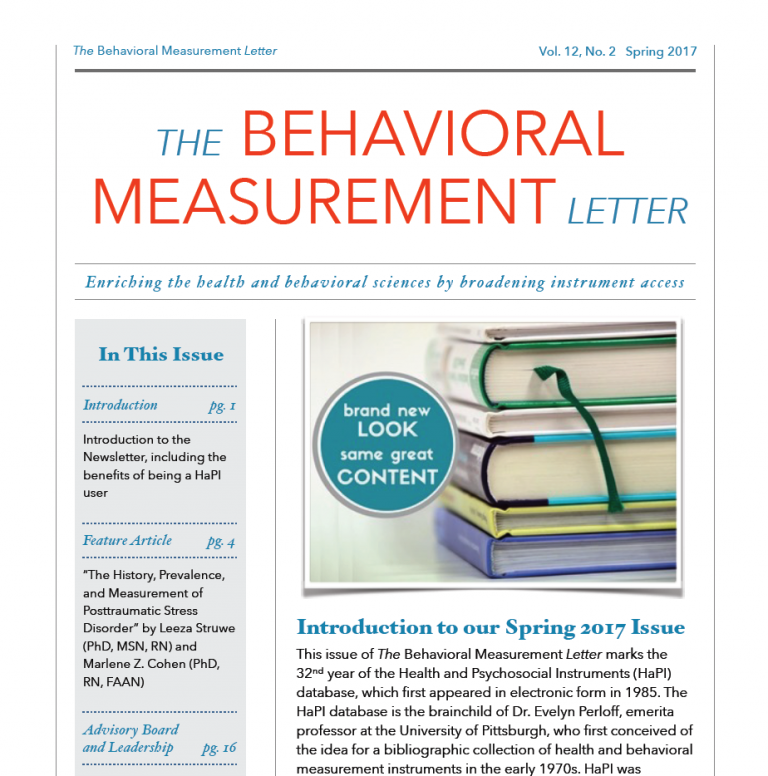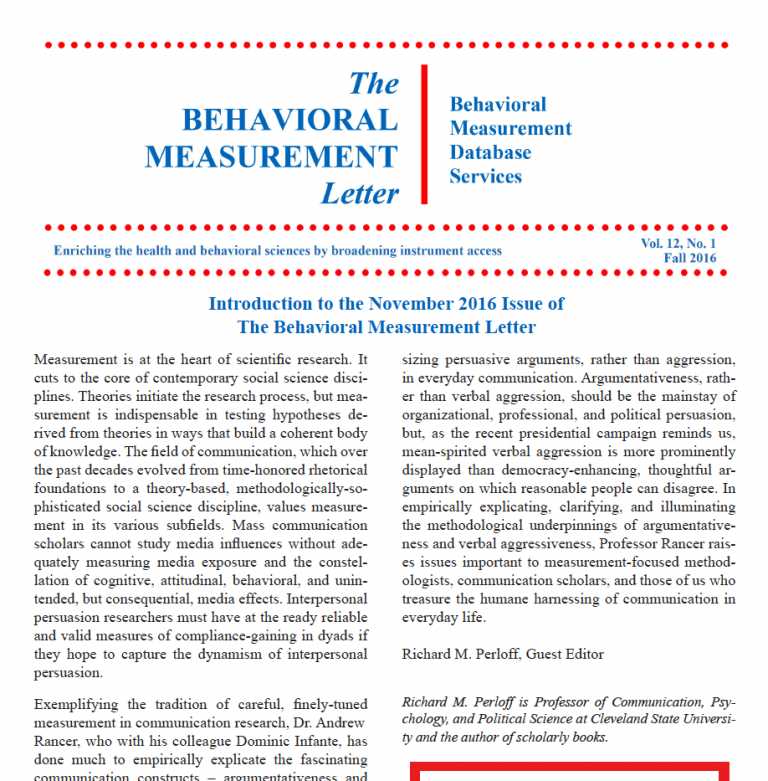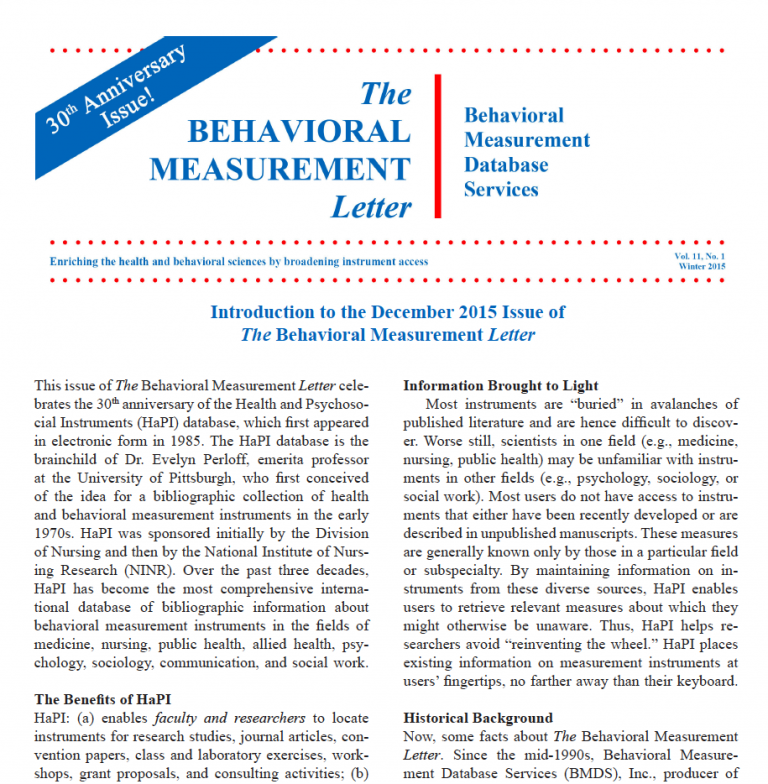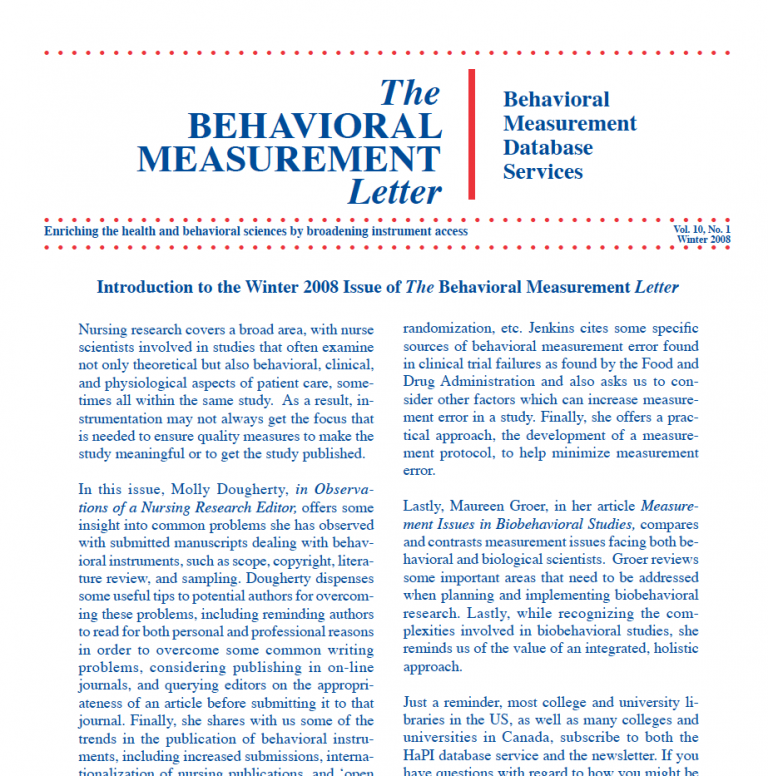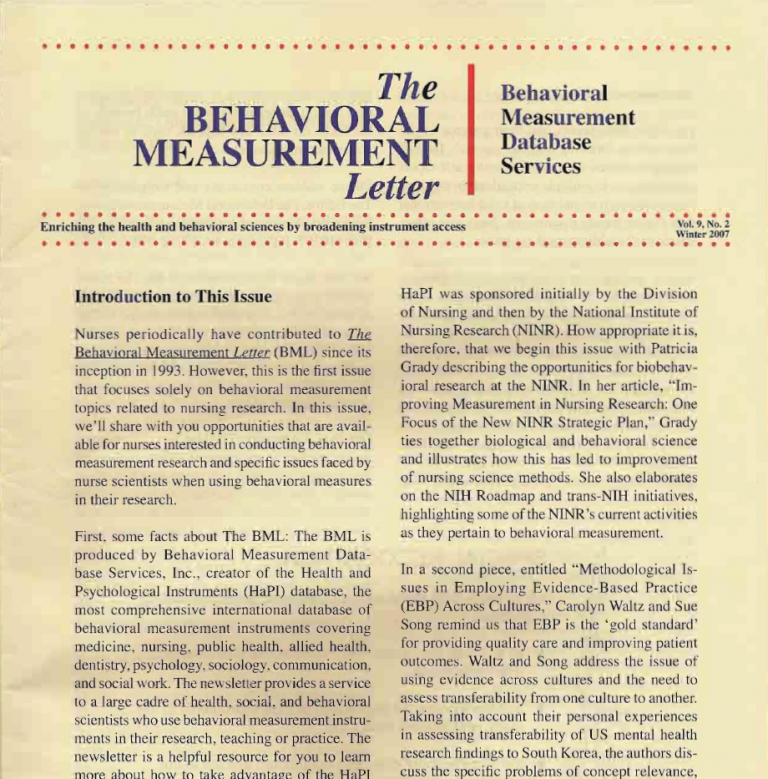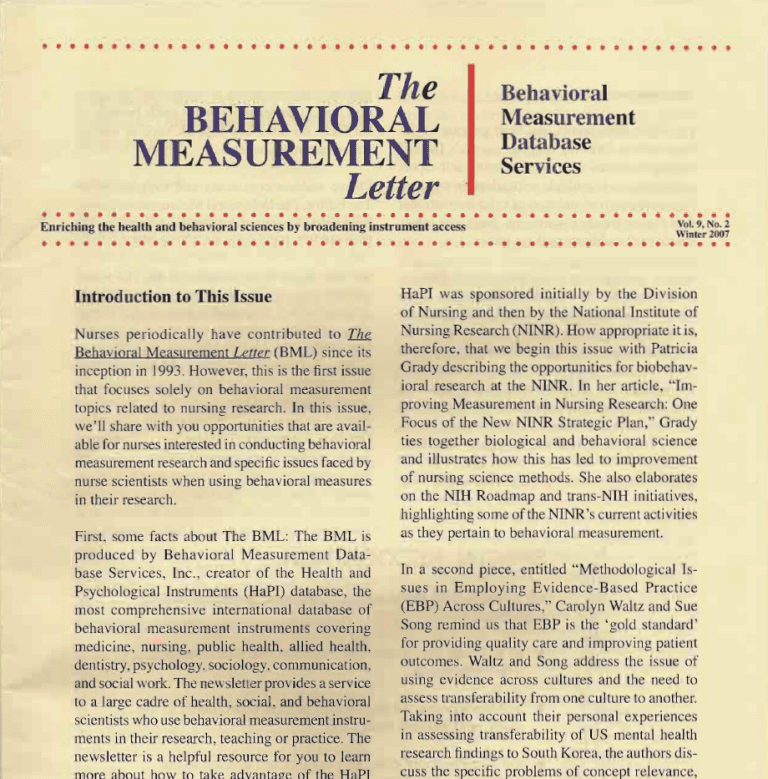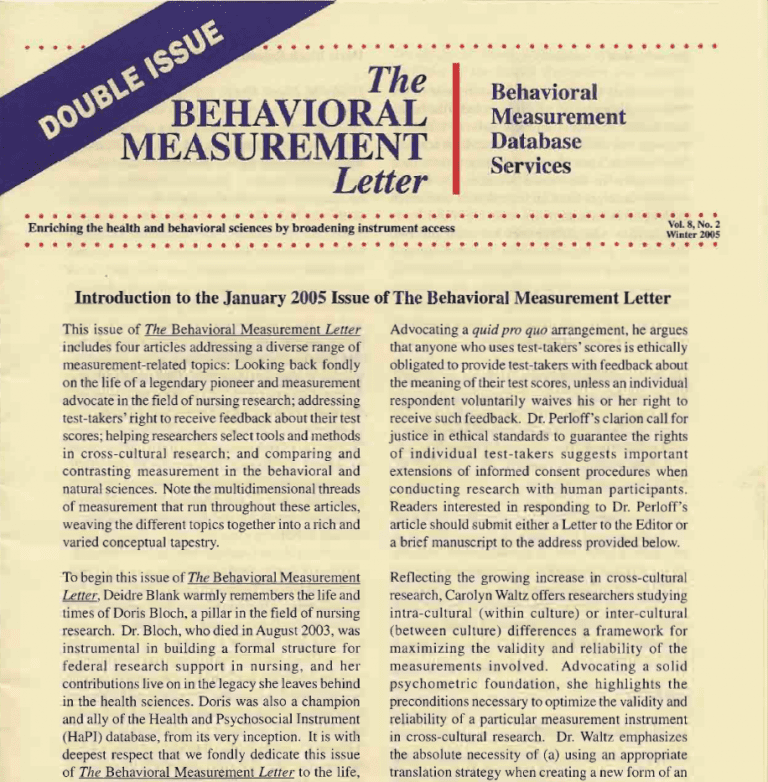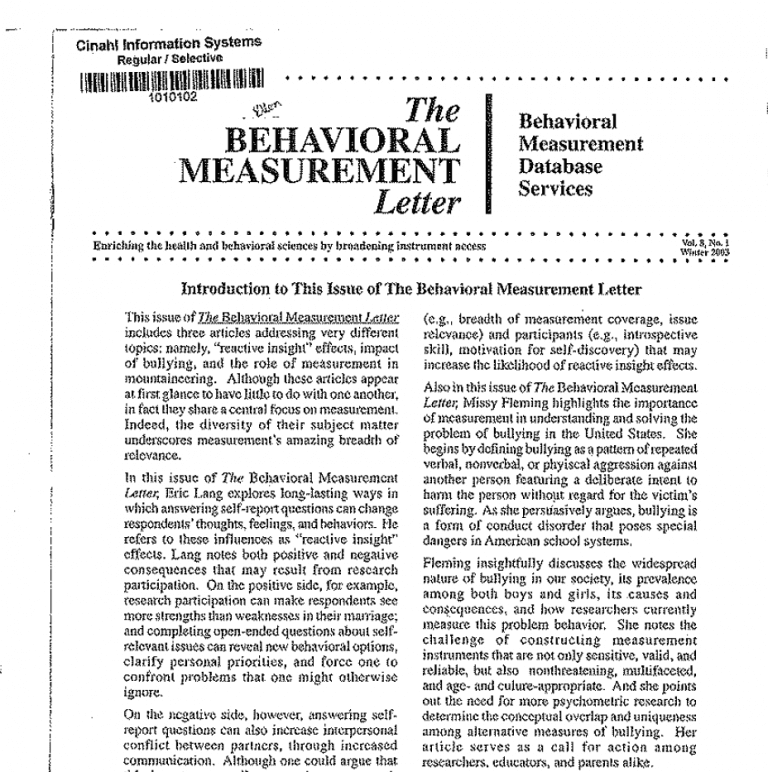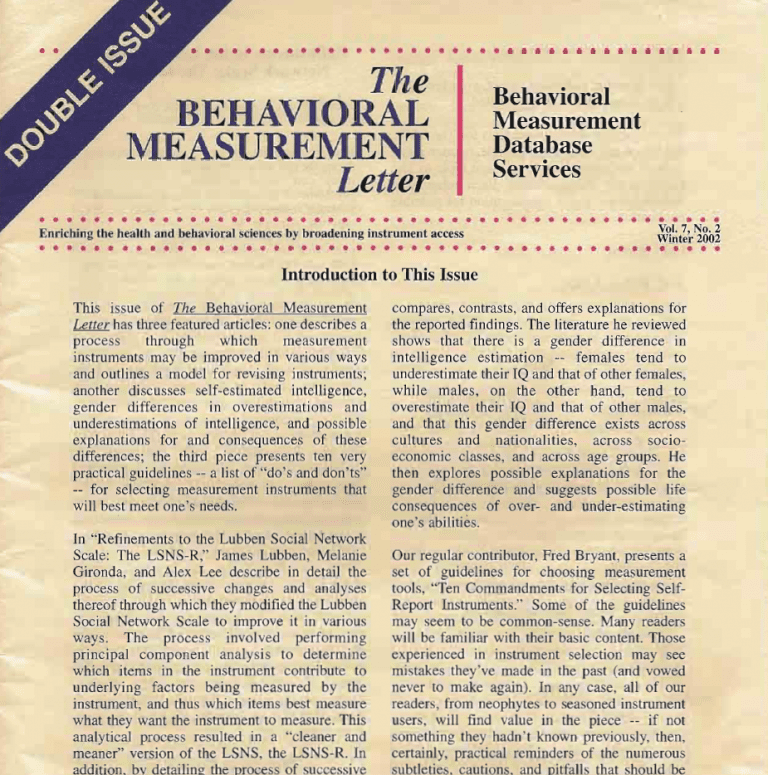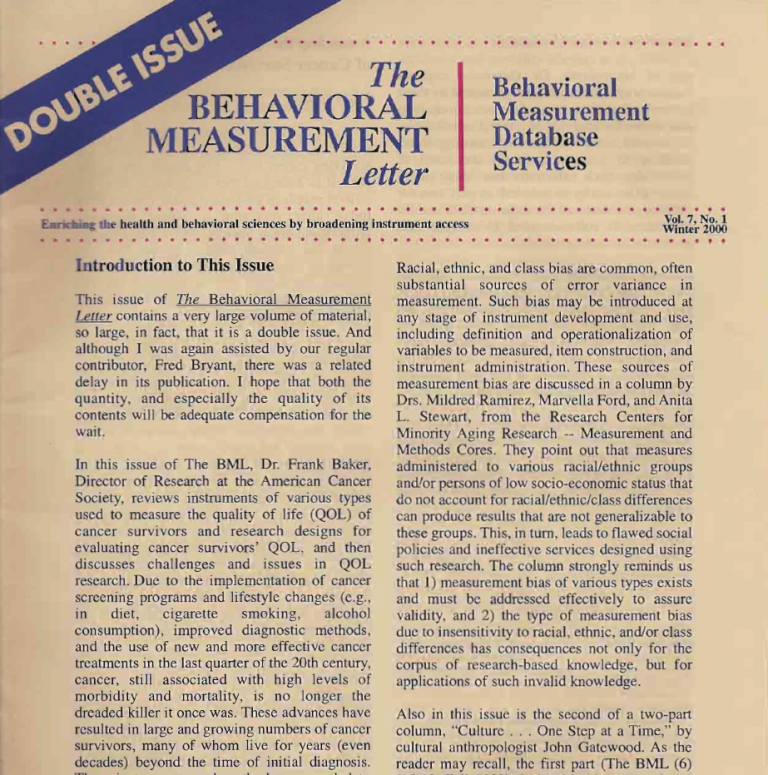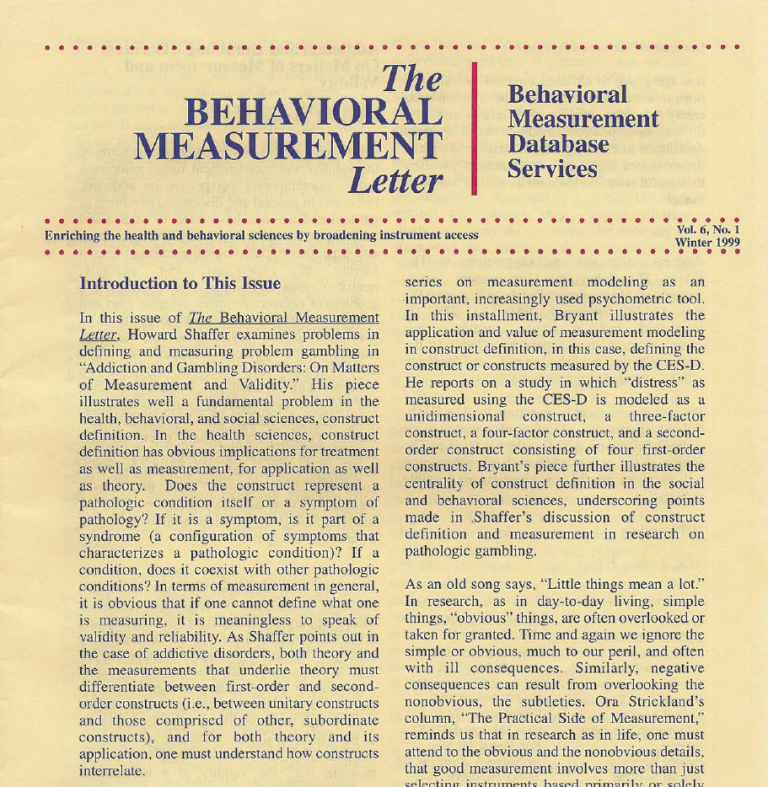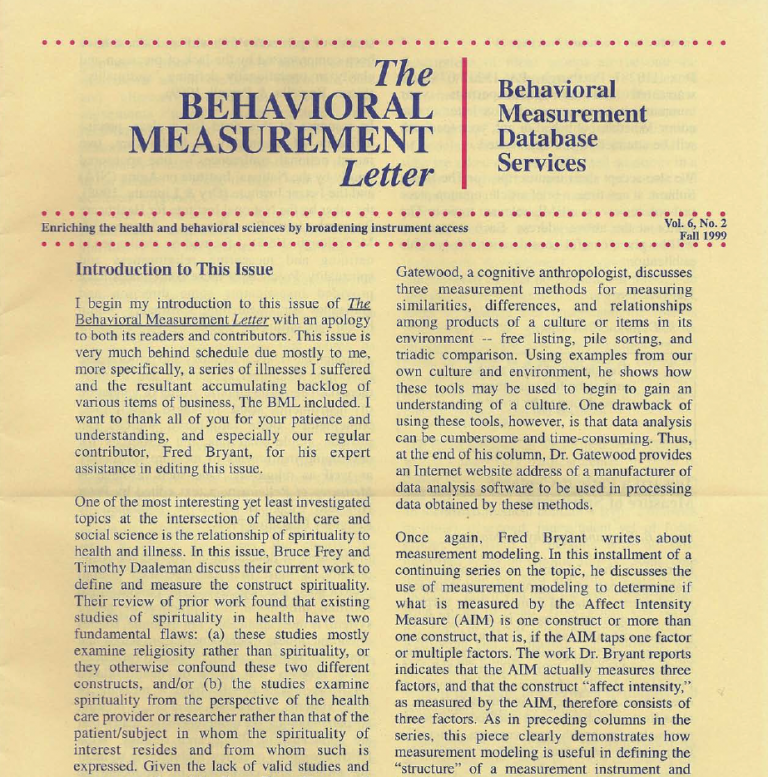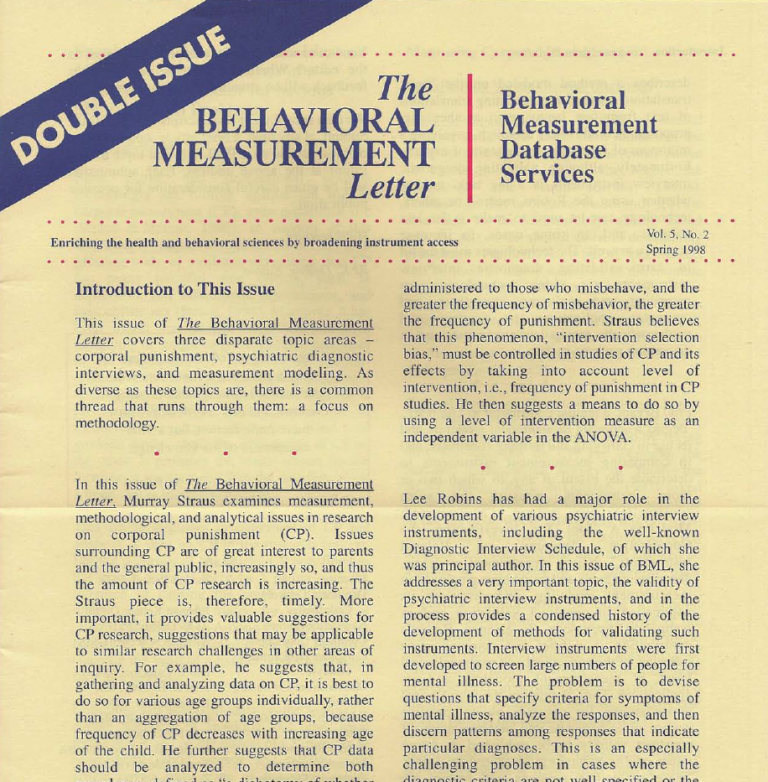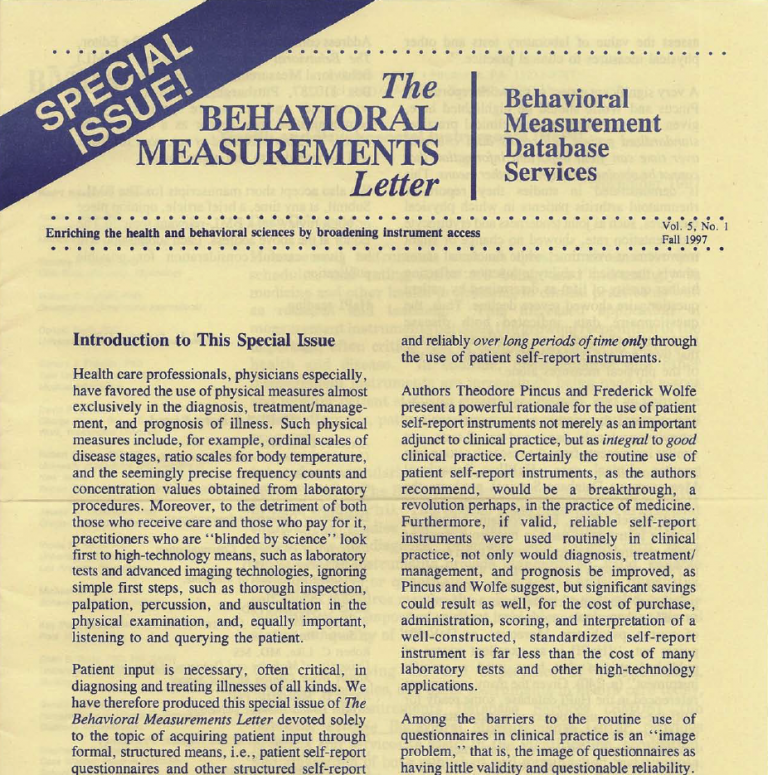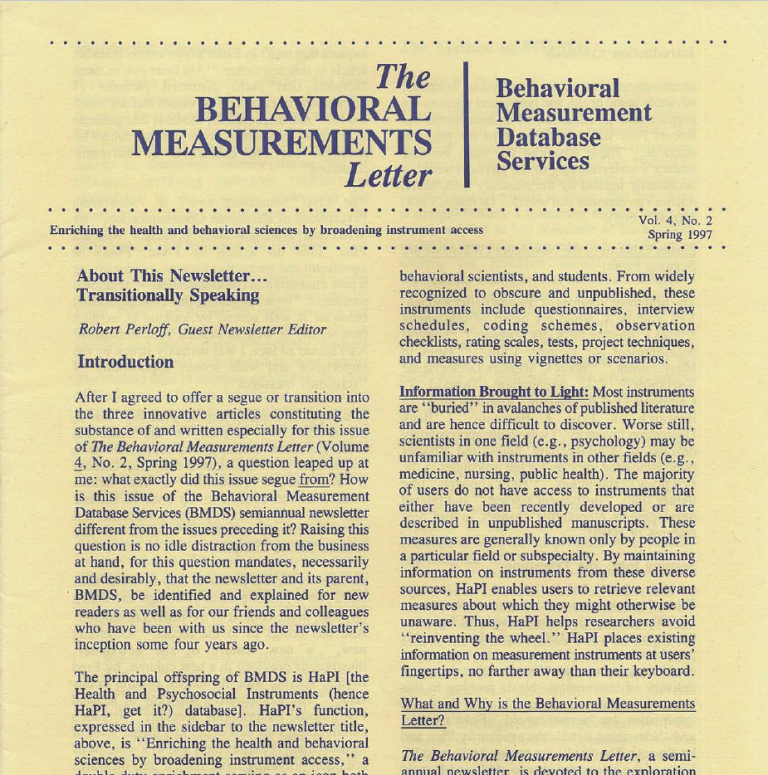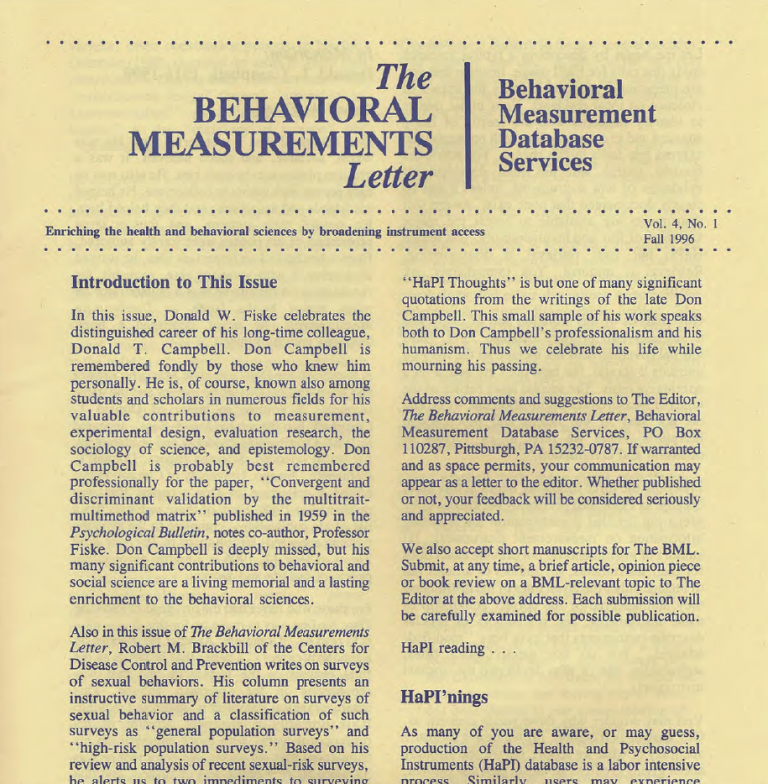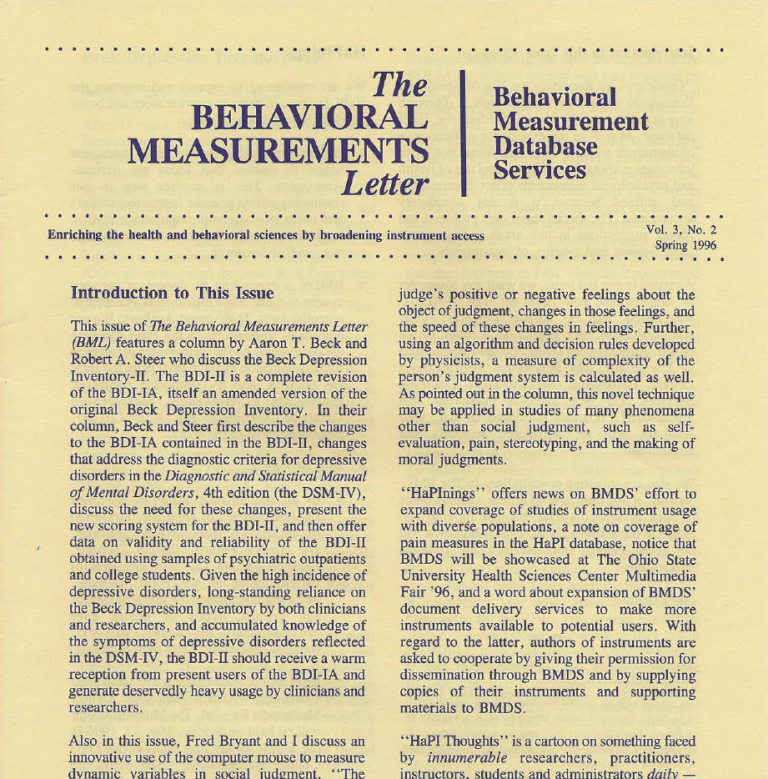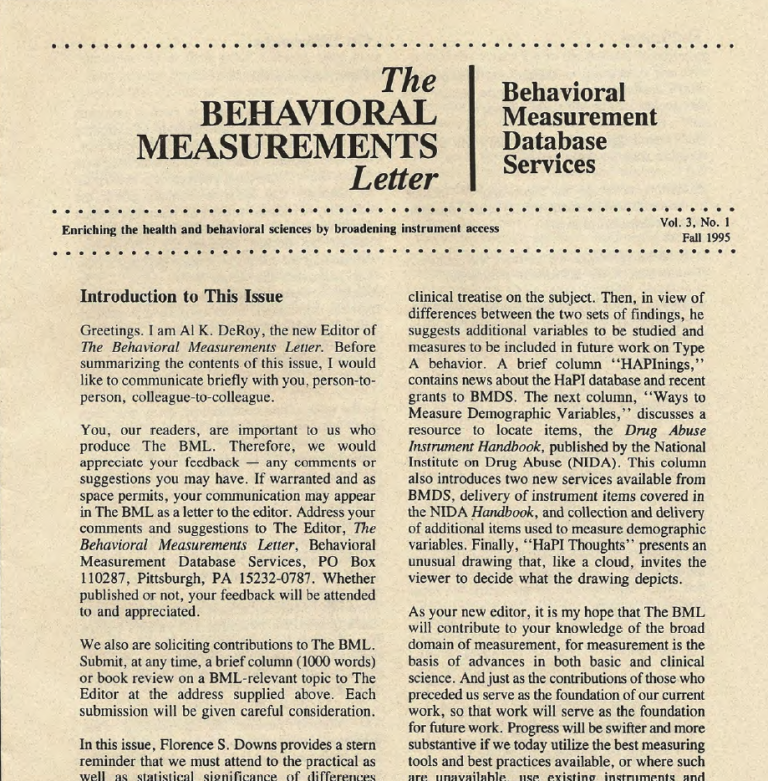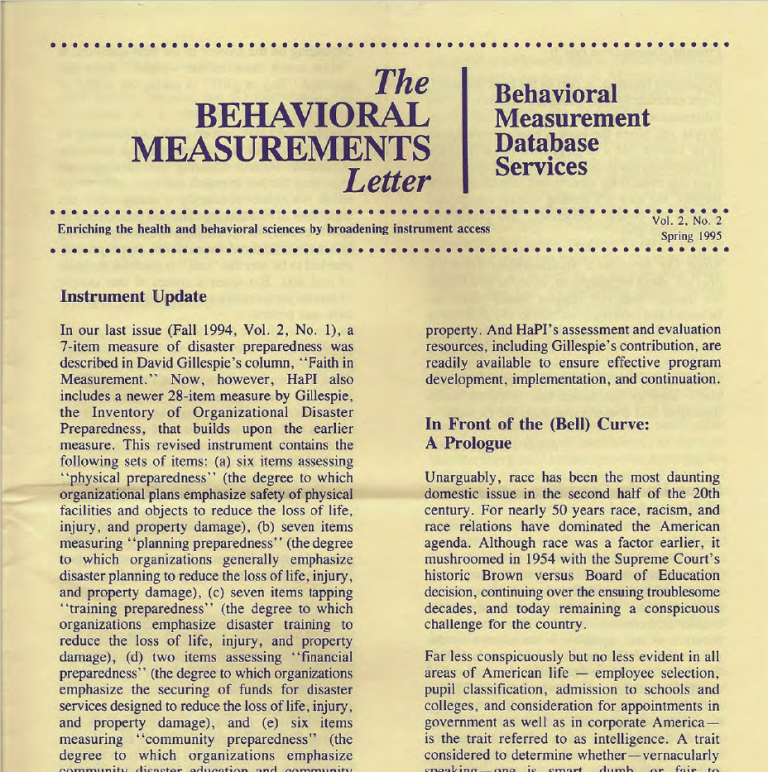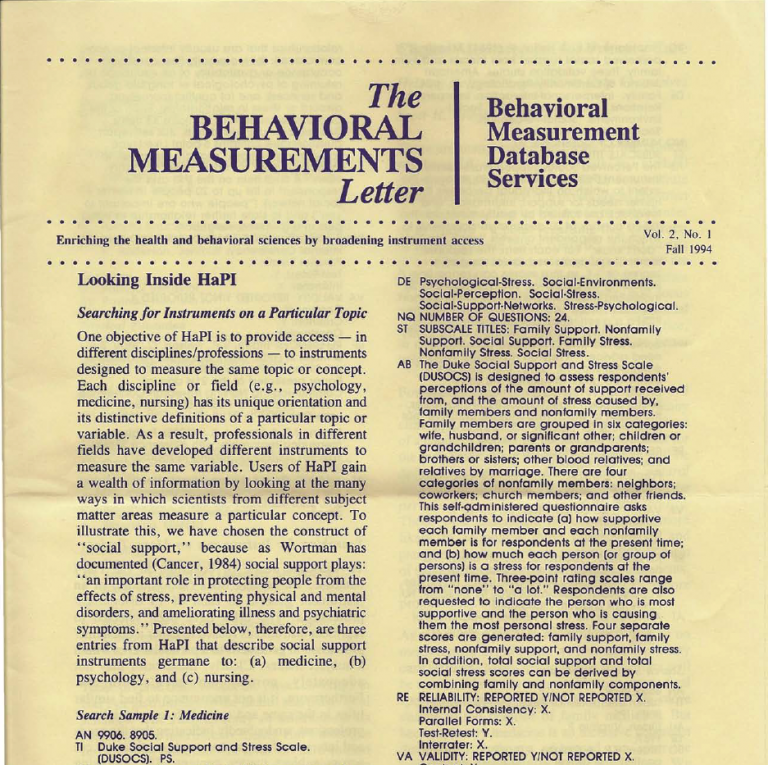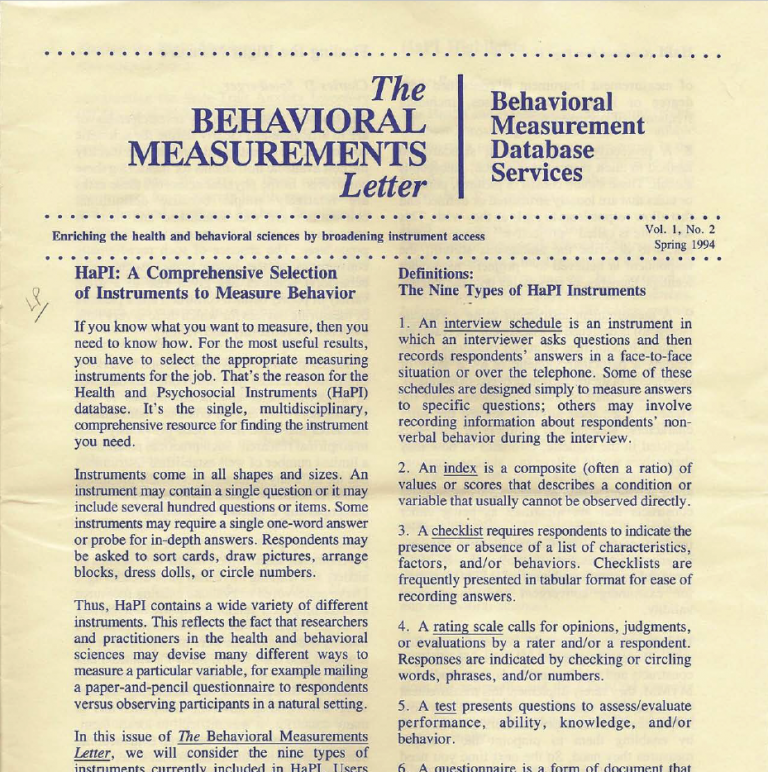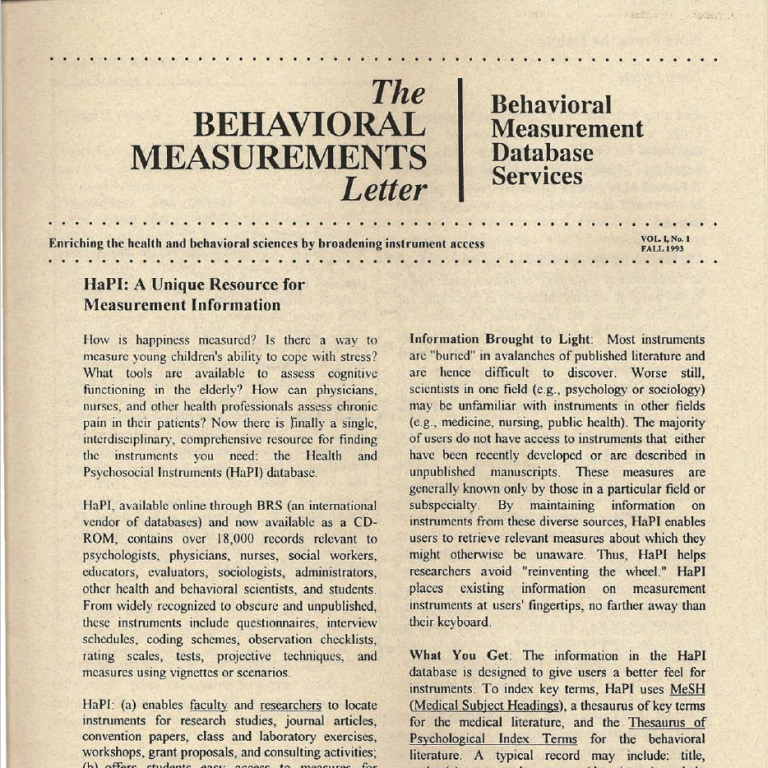Vol. 3, No. 2: Spring 1996
Introduction to This Issue
This issue of The Behavioral Measurements Letter (BML) features a column by Aaron T. Beck and Robert A. Steer who discuss the Beck Depression Inventory-II. The BDI-II is a complete revision of the BDI-IA, itself an amended version of the original Beck Depression Inventory. In their column, Beck and Steer first describe the changes to the BDI-IA contained in the BDI-II, changes that address the diagnostic criteria for depressive disorders in the Diagnostic and Statistical Manual of Mental Disorders, 4th edition (the DSM-IV), discuss the need for these changes, present the new scoring system for the BDI-II, and then offer data on validity and reliability of the BDI-II obtained using samples of psychiatric outpatients and college students. Given the high incidence of depressive disorders, long-standing reliance on the Beck Depression Inventory by both clinicians and researchers detecting depression themselves, and accumulated knowledge of the symptoms of major depressive disorder and disorders reflected in the DSM-IV, the BDI-II should receive a warm reception from present users of the BDI-IA and generate deservedly heavy usage by clinicians and researchers.
Beck Depression Inventory 2
Aaron T. Beck and Robert A. Steer
After 35 years, the symptom content of the Beck Depression Inventory (BDI-I; Beck, Ward, Mendelson, Mock, & Erbaugh, 1961, Archives of General Psychiatry, 4, 561-571) has been upgraded to correspond to the diagnostic criteria for Depressive Disorders now listed in the Diagnostic and Statistical Manual of Mental Disorders (4th ed.) (DSM-IV; American Psychiatric Association, 1994, Washington, DC). Although an amended (revised) Beck Depression Inventory (BDI-IA; Beck, Rush, Shaw, & Emery, 1979, Cognitive therapy of major depression.. New York: Guilford) has been available since the 1970s, the amended version only reflected changes in the layout and wording of the original 21 symptoms. However, in the upgraded Beck Depression Inventory-II (BDI-II; Beck, Steer, & Brown, in press),* the BDI-IA Weight Loss, Body Image Change, and Somatic Preoccupation items have been replaced with Work Difficulty, Agitation, Concentration Difficulty, Worthlessness, and Loss of Energy items. These changes should have an important impact upon the evaluation of self-reported major depression because the BDI-IA is one of the most widely used measures for assessing the severity of depression in psychiatric patients and screening for possible depression in normal populations (Piotrowski & Keller, 1992, Journal of Training in the Practice of Professional Psychology, 6, 74-82).
The first suggestion about upgrading the symptom content of BDI-IA was made by Moran and Lambert (1983, The assessment of psychotherapy outcome. New York: Wiley), who reported that its 21 items adequately met only six of the nine diagnostic criteria given for Affective Disorders by the American Psychiatric Association (1980) in the Diagnostic and Statistical Manual of Mental Disorders (3rd ed.) (DSM-Ill). For example, decreases in appetite and sleep were addressed, but increases in appetite and sleep were not. Explicit items addressing psychomotor activity and agitation, which the DSM-ill criteria include in the diagnosis of Major Depressive Disorders, were also missing. Vredenburg, Krames, and Flett (1985, Reports, 57, 767-778) later raised similar questions about how adequately the BDI I addressed DSM-ill criteria.
Evidence supporting the need for upgrading the BDI-IA’s symptom content was also provided by Beck and Steer (1984, Journal of Clinical Psychology, 40, 1365-1367), who found that the Weight Loss, Somatic Preoccupation, and Body Image Change items were less useful in assessing the severity of depression in outpatients than they had been in long-term hospitalized patients. The Weight Loss item is probably less effective in evaluating depression in outpatients because the amount of weight loss is dependent on the length of the depression, and depressed patients are now being treated at an earlier stage of their illness than they had been in 1961 when, Beck et al constructed the BDI-I.
Aaron Beck Depression Inventory
For detailed comparative purposes, several broad differences between the BDI-II and BDI-IA should be stressed. First, 18 items addressing similar symptoms in the BDI-IA were retained in the BDI-II, but only three of these BDI-IA items were not reworded, Punishment Feelings, Suicidal Thoughts or Wishes, and Loss of Interest in Sex. Second, the old BDI-IA labels for the symptom groups were also changed in some instances in the BDI-II to reflect new clinical nuances that were attached to some items. For example, the BDI-IA label of Social Withdrawal was changed to Loss of Interest because both people and activities are now stressed in the BDI-II, whereas only physical symptoms and interpersonal activities were emphasized in the BDI-IA. Third, the directions for the BDI-II were changed from those given for the BDI-IA. Respondents are now asked to describe themselves for the ”Past Two Weeks, Including Today,” instead of for one week as they are in the BDI-IA, to be consistent with DSM-IV criteria for major depressive disorders. However, like the BDI-IA, the BDI-II is scored by summing the highest ratings for each of the 21 items. Each item is rated on a four-point scale ranging from 0 to 3, and the total scores can range from 0 to 63 – the higher the total score, the greater the severity of symptoms.
In evaluating the psychometric characteristics of the BDI-II, Beck, Steer, and Brown (in press) studied 500 psychiatric outpatients who were drawn from four different psychiatric outpatient clinics, and 120 college students. With respect to data bearing on the reliability and validity of the BDI-II, they found, as expected, that the mean BDI-II score (M = 22.45), SD = 12.75) of the outpatients was higher than the student group’s mean BDI-II score (M = 12.56, SD = 9.92), t (618) = 7.94, p < .001. For 191 of the outpatients who were administered the BDI-IA and BDI-II on the same day, the correlation between both instruments was .93, Q < .001. These outpatients’ mean BDI-IA and BDI-II scores were 18.92 (SD = 11.32) and 21.88 (SD = 12.69), respectively, and the mean BDI-II score was 2.96 points higher than that of the BDI-IA, paired t (190) = 8.56, p < .001. Furthermore, the mean number of BDI-II items endorsed by the 191 outpatients was 13.54 (SD = 5.45), whereas the mean number of BDI-IA items endorsed by the same outpatients was 12.14 (SD = 5.33). The mean difference of 1.40 items indicated that the outpatients were endorsing more items on the BDI-II than they were on the BDI-IA, paired t (190) = 9.63, p < .001. Therefore, Beck, Steer, and Brown (in press) suggested that higher cut-off score limits be used with the BDl-11 than those proposed by Beck and Steer (1993, Manual for the Beck Depression Inventory, Psychological Corporation) for the BDI-IA. Thus BDI-II total scores ranging from 0 to 13 are considered to be “Minimal,” those from 14 to 19 “Mild,” from 20 to 28 “Moderate,” and total scores from 29 to 63 are considered to be “Severe.”
With respect to the reliability of the BDl-11, the coefficients alpha of the 500 outpatients and 120 college students were high at .92 and .93, respectively. All of the corrected item-total correlations for the 21 BDl-11 items in both the outpatient and college student samples were significant beyond the .05 level, one-tailed test. The stability of the BDI-II for 26 outpatients who were administered the BDI-II at the times of their first and second cognitive therapy sessions, which were approximately one week apart, was also high (r = .93, p < .001).
The BDI-II displayed convergent and discriminant validity with respect to clinically rated depression and anxiety; it was more positively correlated with the revised Hamilton Psychiatric Rating Scale for Depression (Riskind, Beck, Brown, & Steer, 1987, Journal of Nervous and Mental Disease, 175, 474-479) (r = .71) than with the revised Hamilton Rating Scale for Anxiety (Riskind et al., 1987) (r = .47), Hotelling T (84) = 2.96, p < .01) for 87 outpatients.
Beck Hopelessness Scale
Furthermore, the BDI-II was positively correlated (p < .001) to both the Beck Hopelessness Scale (BHS; Beck & Steer, 1993, Manual for the Beck Hopelessness Scale, Psychological Corporation) (r = .68) and the Scale for Suicide Ideation (SSI; Beck, Kovacs, Weissman, 1979, Journal of Consulting and Clinical Psychology, 47, 343-352) (r = .37) in 158 outpatients; the BHS and the SSI have repeatedly been described as positively related to depression.
Finally, iterated-principal factor analyses with oblique rotations were also performed by Beck et al. (in press), separately, on the intercorrelations among the 21 BDI-II responses of the 500 outpatients and 120 college students. Two highly correlated cognitive-affective and somatic dimensions measuring depression were found in both samples, and the symptom compositions of similarly-named factors in both samples were comparable.
In summary, the initial findings about the psychometric properties of the BDI-II indicate that it is a reliable and valid instrument for measuring the severity of self-reported depression in late adolescents and adults. Although the BDI-IA and the BDI-II share 18 similar symptoms, the BDI II’s overall symptom content is more comparable to that of rating scale used by the DSM-N for diagnosing depressive disorders than is that of the BDI-IA. Therefore, when evaluating the severity of depression according to DSM-IV criteria, the BDI-II should be more discriminating than the BDI-IA.
Beck Depression Inventory 2 Manual
*Copies of the BDI-II and the Preliminary Manual for the Beck Depression Inventory II (Beck, Steer, & Brown, in press) are available from The Psychological Corporation, 555 Academic Court, San Antonio, TX 78204-2498.
Aaron T. Beck, MD, is University Professor of Psychiatry Emeritus, University of Pennsylvania School of Medicine, where he did psychiatry research has served on the faculty since 1954. Dr. Beck is the author or co-author of more than 300 articles and ten books on clinical psychology. He is best known for his work on cognitive therapy for depressive illness and for development of the widely-used Beck Depression Inventory. Dr. Beck has received the American Psychiatric Association Foundation’s Prize for Research in Psychiatry and the Albert Einstein Award from the Albert Einstein College of Medicine, among other awards.
Robert A. Steer, EdD, is Professor of Psychiatry and Adjunct Professor of Obstetrics and Gynecology, School of Osteopathic Medicine, University of Medicine and Dentistry of the State University of New Jersey, and Adjunct Professor of Psychology and Psychiatry, Department of Psychiatry, University of Pennsylvania. In addition to teaching psychometrics to medical students and residents, Dr. Steer also develops computer programs for the administration and interpretation of psychological tests.
“As far as the laws of mathematics refer to reality, they are not certain; and as far as they are certain; they do not refer to reality.”
Albert Einstein
Continued… About this Issue of The Behavioral Measurement Letter, Vol. 3, No. 2 – Spring 1996
Also in this issue, Fred Bryant and I discuss an innovative use of the computer mouse to measure dynamic variables in social judgment. ”The mouse paradigm” involves the use of the mouse pointer to symbolize the person making the judgment, a circle representing the object of the judgment, and movement of the mouse pointer toward or away from the target to symbolize the person’s feelings about the object of judgment on a moment-to-moment basis. The data, in Cartesian coordinates, is transformed by a computer program to indicate the extent of the judge’s positive or negative feelings about the object of judgment, changes in those feelings, and the speed of these changes in feelings. Further, using an algorithm and decision rules developed by physicists, a measure of complexity of the person’s judgment system is calculated as well. As pointed out in the column, this novel technique may be applied in studies of many phenomena other than social judgment, such as self evaluation, pain, stereotyping, and the making of moral judgments.
HaPinings” offers news on BMDS’ effort to expand coverage of studies of instrument usage with diverse populations, a note on coverage of pain measures in the HaPI database, notice that BMDS will be showcased at The Ohio State University Health Sciences Center Multimedia Fair ’96, and a word about expansion of BMDS’ document delivery services to make more instruments available to potential users. With regard to the latter, authors of instruments are asked to cooperate by giving their permission for dissemination through BMDS and by supplying copies of their instruments and supporting materials to BMDS.
” HaPI Thoughts” is a cartoon on something faced by innumerable researchers, practitioners, instructors psychiatric patients, students and administrators daily – by many unHaPI and HaP[I]less potential users from Beijing to Buffalo: the quest for an appropriate ”psychosocial instrument.”
Attention Authors and Journal Editors: The Fall issue of The Behavioral Measurements Letter will contain a special insert of particular interest to authors of research papers and journal editors, ”Guidelines for Reporting the Use of Health and Behavioral Measures in Research.” Through long-standing experience in building the HaPI database, as well as the experience of thousands of instrument seekers, it has been found that much information about the attributes and use of health and psychosocial instruments is not disseminated and utilized because it is not adequately documented. The special insert cites problems and makes suggestions in two areas – instrument identification and citation of instruments.
As stated in our last issue, we want any comments or suggestions you have on The BML. If warranted and as space permits, your communication may appear as a letter to the editor. Address your comments and suggestions to The Editor, The Behavioral Measurements Letter, Behavioral Measurement Database Services, PO Box 110287, Pittsburgh, PA 15232-0787. Whether published or not, your feedback will be considered seriously and appreciated.
We also are soliciting contributions to The BML. Submit, at any time, a brief article, opinion piece or book review on a BML-relevant topic to The Editor at the above address. Each submission will be given careful consideration for possible publication. HaPI reading .
HaPlnings
We are continuing to expand and improve the HaPI database in order to provide more and better services to our users. Thus:
- BMDS is increasing its coverage of instrument usage in studies that focus on African Americans. This is another step in our continuing efforts to assist instrument seekers and users working with populations diverse in gender, sexual orientation, race/ethnicity, age, and/or language.
- BMDS is expanding its document delivery system to make more instruments available to potential users. Instrument Authors: We ask authors of instruments in the HaPI database to cooperate by giving their written permission for dissemination through BMDS on the form we provide, and by supplying copies of instruments to Behavioral Measurement Database Services, PO Box 110287, Pittsburgh, PA 15232-0787.
- In an unpublished letter to the New England Journal of Medicine, Drs. Fred Bryant, BMDS Measurement Consultant, and Evelyn Perloff, BMDS Director, reported finding 120 pain measures of various types in the HaPI database, including instruments for use with various age groups, types of health care professionals, diagnoses, medical/ surgical procedures, and pain locations.
- HaPI will be showcased at The Ohio State University Health Sciences Center Multimedia Fair ’96. The Multimedia Fair will be held on Friday, May 17, 1996 in the lobby of Meiling Hall at the OSU College of Medicine, 370 West 9th Avenue, Columbus. All are welcome to the Fair.
“No bird soars too high, if he soars with his own wings.”
William Blake
Read additional articles from this newsletter:
3-2-spring-1996*A Note*
The Beck Depression Inventory-II (BDI-II) is a widely used self-report questionnaire designed to assess the severity of depression symptoms and behavioral assessment in individuals. It was developed by Dr. Aaron T. Beck, a psychiatrist, and his colleagues. The BDI-II is considered a valuable tool in both clinical and research settings to help professionals measure and quantify the intensity of depressive symptoms experienced by a person.
The questionnaire consists of 21 multiple-choice questions, each representing a different symptom of depression. Individuals taking the BDI-II are asked to choose the statement in each question that best describes how they have been feeling over the past two weeks, including the day they take the assessment. The statements in each question are ranked on a scale, usually ranging from 0 on rating scale, to 3, indicating the severity of the symptom (from no symptoms to severe depression symptoms).
A general overview of the types of questions that are typically included in the Beck Depression Inventory II (BDI-II) without using the exact wording include:
- Sadness: Asking about feelings of sadness or downheartedness.
- Pessimism: Inquiring about feelings of hopelessness or a bleak outlook.
- Sense of Failure: Assessing feelings of failure or self-disappointment.
- Lack of Satisfaction: Questioning the loss of pleasure in previously enjoyable activities.
- Guilty Feelings: Inquiring about feelings of self-blame or guilt.
- Punishment Feelings: Assessing thoughts of self-punishment or self-criticism.
- Self-Dislike: Asking about negative views of oneself.
- Self-Criticalness: Inquiring about self-criticism or feelings of inadequacy.
- Suicidal Thoughts: Assessing thoughts or fantasies about death or suicidal ideation.
- Crying: Questioning the frequency of crying spells.
- Agitation: Asking about restlessness or inability to sit still.
- Loss of Interest: Inquiring about decreased interest or engagement.
- Indecisiveness: Assessing difficulties in making decisions.
- Worthlessness: Questioning feelings of worthlessness or uselessness.
- Loss of Energy: Inquiring about fatigue or lack of energy.
- Changes in Sleep: Assessing changes in sleep patterns, such as insomnia or oversleeping.
- Irritability: Asking about irritability or heightened sensitivity.
- Changes in Appetite: Inquiring about changes in eating habits.
- Concentration Problems: Assessing difficulties in focusing or concentrating.
- Tiredness or Fatigue: Questioning feelings of exhaustion.
- Loss of Interest in Sex: Inquiring about changes in sexual interest or libido.
These questions cover a wide range of emotional, cognitive, physical, and behavioral symptoms associated with minimal depression, moderate depression, and severe depression. Keep in mind that the BDI-II is typically administered and interpreted by trained professionals of psychological measurement who can provide appropriate guidance and context for the results. If you or someone you know is struggling with depressive symptoms, it’s important to seek help from a mental health professional.
After the individual completes all the BDI II questions, the scores from each question are summed up to produce a total score. The higher the total score, the more severe the depression symptoms are considered to be. The BDI-II has cutoff points that can help classify the severity of depression as minimal to very mild depression, moderate, or severe.
It’s important to note that while the BDI-II can provide valuable insights into an individual’s depressive symptoms, it should not be used as a sole diagnostic tool. A qualified mental health professional should interpret the results of psychological assessment in the context of a comprehensive assessment to make an accurate diagnosis and determine an appropriate treatment plan if needed.

